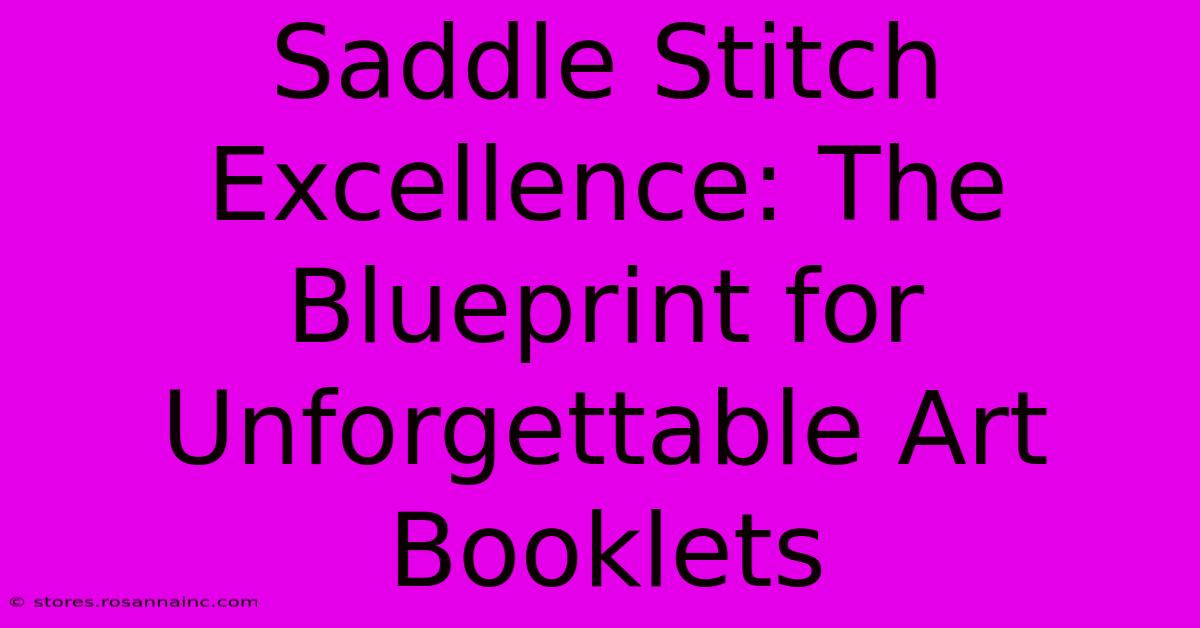Saddle Stitch Excellence: The Blueprint For Unforgettable Art Booklets

Table of Contents
Saddle Stitch Excellence: The Blueprint for Unforgettable Art Booklets
Creating a stunning art booklet requires more than just beautiful images; it demands meticulous attention to detail, especially in the binding. The saddle stitch, with its clean and classic aesthetic, remains a popular choice for showcasing art, but achieving true excellence requires understanding its nuances. This comprehensive guide provides a blueprint for crafting unforgettable art booklets using the saddle stitch binding method.
Understanding the Saddle Stitch: Strengths and Limitations
The saddle stitch, also known as a "saddle wire" or "center stitch," is a binding method where folded sheets of paper are secured together by wire staples along the spine. Its simplicity belies its effectiveness, particularly for projects with a relatively low page count (typically under 64 pages).
Strengths:
- Cost-Effective: Saddle stitching is generally the most affordable binding option.
- Clean Aesthetic: The finished product boasts a flat, professional look, perfect for showcasing artwork.
- Easy to Read: The pages lay flat, making it comfortable for readers to peruse your artwork.
- Fast Production: Saddle stitch binding is quick and efficient.
Limitations:
- Page Count Restrictions: As mentioned, the method is best suited for thinner booklets.
- Spine Thickness: The spine's thickness is limited, restricting the overall size and weight of the booklet.
- Not Suitable for All Projects: It's not ideal for projects requiring heavier paper stock or intricate designs.
Designing for Saddle Stitch Perfection: Key Considerations
Designing your art booklet specifically for saddle stitch binding ensures a seamless and professional result. Here are key aspects to focus on:
1. Paper Selection: Quality Matters
The paper you choose significantly impacts the final product's look and feel. Consider:
- Weight: Choose a paper weight that balances quality with affordability and the booklet's overall thickness. Too thin, and the booklet may feel flimsy; too thick, and it may exceed the saddle stitch's limitations.
- Texture: Experiment with different textures to enhance the visual appeal of your artwork. A textured paper can add depth and elegance.
- Finish: Glossy or matte finishes can affect how the colors and images are displayed. Consider your artwork's style when making this decision.
2. Layout and Design: Optimizing for Readability and Impact
- Bleed: Design your artwork to extend slightly beyond the trim lines (bleed) to prevent white borders after trimming.
- Margins: Maintain consistent margins to ensure a clean and professional look.
- Image Placement: Consider the flow of your images and their relationship to the page layout.
- Font Selection: Use a legible font that complements your artwork's style.
3. Preparing Your Files: Ensuring Print-Readiness
Before sending your files to the printer, ensure they meet their specifications. This typically includes:
- Correct File Format: Provide your files in a format suitable for printing (e.g., PDF).
- Color Profile: Use the correct color profile (e.g., CMYK) to avoid color discrepancies.
- Resolution: Ensure your images have a high enough resolution (at least 300 DPI) to avoid pixelation.
- Proofreading: Thoroughly proofread your booklet to catch any errors before printing.
Choosing the Right Printer: Partnering for Success
Selecting a reputable printer is crucial for achieving saddle stitch excellence. Look for printers with experience in art booklet production and who can provide guidance on paper choices, file preparation, and finishing options.
Beyond the Basics: Elevating Your Art Booklet
To truly create an unforgettable art booklet, consider these additional elements:
- Cover Stock: Use a heavier cover stock to add durability and visual impact.
- Spot UV Coating: Add a spot UV coating to selected elements for a luxurious touch.
- Embossing or Debossing: Consider embossing or debossing your cover for a more sophisticated look.
By meticulously following these steps, you can transform your art into a tangible masterpiece, creating a truly unforgettable art booklet using the timeless elegance of the saddle stitch. Remember, attention to detail in every aspect, from paper selection to final finishing, is the key to achieving saddle stitch excellence.

Thank you for visiting our website wich cover about Saddle Stitch Excellence: The Blueprint For Unforgettable Art Booklets. We hope the information provided has been useful to you. Feel free to contact us if you have any questions or need further assistance. See you next time and dont miss to bookmark.
Featured Posts
-
Transform Your Home Into A Sanctuary Of Hygiene With Our Vip Cleaning Card
Feb 04, 2025
-
Smart Fridges For Smart Cities The Ultimate Guide To City Chill Refrigerators
Feb 04, 2025
-
Unveiling The Gel Polish Kit Thats Every Nail Enthusiasts Dream
Feb 04, 2025
-
Elevate Your Prose Empowering Passives To Actives
Feb 04, 2025
-
Attention Email Nerds How To Optimize Your Signature For Side Splitting Results
Feb 04, 2025
